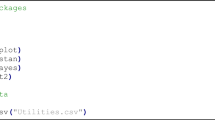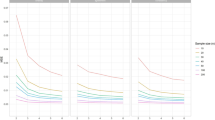Abstract
Kodell and West (1993) describe two methods for calculating pointwise upper confidence limits on the risk function with normally distributed responses and using a certain definition of adverse quantitative effect. But Banga et al. (2000) have shown that these normal theory methods break down when applied to skew data. We accordingly develop a risk analysis model and associated likelihood-based methodology when the response follows either a gamma or reciprocal gamma distribution. The model supposes that the shape (index) parameter k of the response distribution is held fixed while the logarithm of the scale parameter is a linear model in terms of the dose level. Existence and uniqueness of the maximum likelihood estimates is established. Asymptotic likelihood-based upper and lower confidence limits on the risk are solutions of the Lagrange equations associated with a constrained optimization problem. Starting values for an iterative solution are obtained by replacing the Lagrange equations by the lowest order terms in their asymptotic expansions. Three methods are then compared for calculating confidence limits on the risk: (i) the aforementioned starting values (LRAL method), (ii) full iterative solution of the Lagrange equations (LREL method), and (iii) bounds obtained using approximate normality of the maximum likelihood estimates with standard errors derived from the information matrix (MLE method). Simulation is used to assess coverage probabilities for the resulting upper confidence limits when the log of the scale parameter is quadratic in the dose level. Results indicate that coverage for the MLE method can be off by as much as 15% points and converges very slowly to nominal coverage levels as the sample size increases. Coverage for the LRAL and LREL methods, on the other hand, is close to nominal levels unless (a) the sample size is small, say N < 25, (b) the index parameter is small, say k ≤ 1, and (c) the direction of adversity is to the left for the gamma distribution or to the right for the reciprocal gamma distribution.
Similar content being viewed by others
References
Andrews, L.C. (1985) Special Functions for Engineers and Applied Mathematicians, Macmillan, New York.
Banga, S.J., Patil, G.P., and Taillie, C. (2000) Sensitivity of normal theory methods to model misspecification in the calculation of upper confidence limits on the risk function for continuous responses. Environmental and Ecological Statistics, 7, 177–89.
Banga, S.J., Patil, G.P., and Taillie, C. (2001a) Likelihood contour method for the calculation of asymptotic upper confidence limits on the risk function for quantitative responses. Risk Analysis 21(4), 613–623.
Banga, S.J., Patil, G.P., and Taillie, C. (2001b) Direct calculation of likelihood-based benchmark dose levels for quantitative responses. Environmental and Ecological Statistics 9, 295–315.
Bowman, K.O. and Shenton, L.R. (1988) Properties of Estimators for the Gamma Distribution, Marcel Dekker, New York.
Chen, J.J. and Gaylor, D.W. (1992) Dose response modeling of quantitative response data for risk assessment. Communications in Statistics—Theory and Methods, 21(8), 2367–81.
Crump, K.S. (1984) A new method for determining allowable daily intakes. Fundamental and Applied Toxicology, 4, 854–971.
Crump, K.S. (1995) Calculation of benchmark doses from continuous data. Risk Analysis, 15, 79–89.
Crump, K.S. and Howe, R. (1983) A review of methods for calculating confidence intervals in low dose extrapolation. In Toxicological Risk Assessment, D.B Clayson, D. Krewski and I. Munro (eds), CRC Press, Boca Raton, FL.
Gaylor, D.W. and Slikker, Jr., W. (1990) Risk assessment for neurotoxic effects. Neurotoxicology, 11, 211–8.
Glowa, J.R. (1991) Dose-effect approaches to risk assessment. Neuroscience and Behavioral Reviews, 15, 153–8.
Kodell, R.L. and West, R.W. (1993) Upper confidence limits on excess risk for quantitative responses. Risk Analysis, 13(2), 177–82.
Rao, C.R. (1947) Large sample tests of statistical hypotheses concerning several parameters with applications to problems of estimation. Proceedings of the Cambridge Philosophical Society, 44, 50–7.
Sciullo, C., Patil, G.P., and Taillie, C. (2000) Approximate validity of benchmark dose levels obtained by inverting upper confidence bounds on the risk function. Technical Report Number 2000–0404, Center for Statistical Ecology and Environmental Statistics, Department of Statistics, Penn State University, University Park, PA.
Stiteler, W.M. and Durkin, P.R. (1990) Some Statistical Issues Relating to the Characterization of Risk for Toxic Chemicals. Proceedings of the Workshop on Superfund Hazardous Waste: Statistical Issues in Characterizing a Site: Protocols, Tools, and Research Needs, Arlington, Virginia, February 21–2.
West, R.W. and Kodell, R.L. (1993) Statistical methods of risk assessment for continuous variables. Communications in Statistics—Theory and Methods, 22(12), 3363–76.
Author information
Authors and Affiliations
Rights and permissions
About this article
Cite this article
Banga, S., Patil, G.P. & Taillie, C. Continuous dose-response modeling and risk analysis with the gamma and reciprocal gamma distributions . Environmental and Ecological Statistics 9, 273–293 (2002). https://doi.org/10.1023/A:1016292226899
Issue Date:
DOI: https://doi.org/10.1023/A:1016292226899




